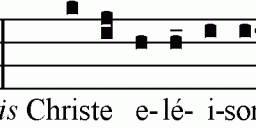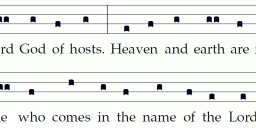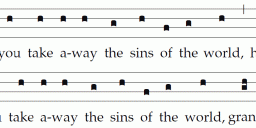Free Artwork for ICEL Chant Mass in Neumes
-
Here is the artwork in GIF format for the ICEL Chant mass for the Assembly 2010. This version is in neumes (square notes), and is designed to be printed on A5 mass leaflets using a 1/4" or 0.7cm margin.
Kyrie, Gloria, Sanctus and Agnus Dei.
I might do the artwork for the three Mysterium Fidei, but I generally don't bother printing those in mass leaflets.
The ICEL Chant Mass remains the property of ICEL (C) 2010. I believe that the permission for this mass setting is that it may be reproduced in liturgy guides for specific events and performed without royalties for free, but if it is printed in missals or on mass-card that a fee applies.

 Kyrie_XVI.gif1628 x 200 - 8K
Kyrie_XVI.gif1628 x 200 - 8K
 Gloria IV English.gif935 x 1280 - 69K
Gloria IV English.gif935 x 1280 - 69K
 Sanctus 2-line.gif1617 x 335 - 25K
Sanctus 2-line.gif1617 x 335 - 25K
 Agnus Dei 2 line.gif1391 x 335 - 21K
Agnus Dei 2 line.gif1391 x 335 - 21K -
I don't want to offend anyone, but I find the concept of printing something in neumes that wasn't written in them to be nothing short of goofy. My congregation sings the ICEL chant mass from the hymnal where it is written in round notes - stemless round notes, that is. I looked in the missal and it is the same. What is the objective here?
-
I was about to say I think it's goofy when hymnals print something in round notes that was written in neumes, but then I realized that would be a goofy thing to say. Let there be chant in neumes and round notes, I say, and use whichever you think best, and have the humility to realize that whichever you choose, the other isn't goofy.
-
I am fine with Gregorian chant that was originally written in neumes. That's authentic. But do you really consider the ICEL English chants to be Gregorian?
-
The reasonable basis for choosing neumes or round notes is that you find them useful. If you think it's useful to set Mass XI in round notes, fine. If you think it's useful to set the ICEL chants in neumes, fine. Neither choice is goofy.
-
Perhaps authentic and inauthentic would be better descriptions.
-
I don't find authenticity a useful metric by which to determine what notation system to use for a particular piece of music. Authenticity is so subjective a concept that it results in unproductive disputes. Also, if setting Mass XI in round notes helps someone sing it well, even supposing that is inauthentic, whatever that means, why should I object?
-
Aren't we splitting hairs here with the ICEL chants? I don't see someone taking a look at one or the other notational system for the first time and having some great epiphany about how to perform a predominantly syllabic piece:
"OH! If I just sing this syllable as a square [or circle], it all comes together!"
When something is truly lost in the transcription, as is frequently the case, then we're in the gray areas of authenticity and performance practice.
As for goofy, well, there's a lot of goofy stuff out there. -
Personally, it seems much more authentic to engrave them in neumes, since the chants they are closely modeled after are in neumes. How they are presented in the missal seems beside the point. Their source is really in neumes, so if you want to look at it that way, neumes seems the better option.
If you want to get them singing lots of latin parts in neumes, then it would seem reasonable to start with the ICEL chants in neumes. If you're using the english gloria alongside a greek/latin kyrie, sanctus, agnus dei, then it might make sense to use neumes. But like it was said above, do whatever works best for you, your goals, and your congregation's abilities. Suum cuique. -
Are, for example, the Simple English Propers by Adam Bartlett authentic or inauthentic? They are published in neumes.
Are my own plainchant compositions authentic or inauthentic? They are published in neumes.
I can't say that Adam's or my chant compositions were "written" (composed?) in neumes. In Adam's case, it's because I don't know his composing process. In my case, I sang the works into existence, notated them crudely (sometimes round sometimes square notes), and finally sometime in the fine-tuning process engraved them with neumes, especially because I thought that 4-line neumesque notation would be better suited to the kind of chant.
I cannot for the life of me see that either of us (or a lot of other stuff) is inauthentic.
For me, round notes are generally preferable for notating accompanied chants (and for chant accompaniments). If neumesque notation is an impenetrable stumbling block for inflexible singers, then round notes are a viable alternative.
-
Ideally, we should teach our singers both systems, I would think. But how much of this is what is best for the singers and performance, and how much of it is, at times, anachronism run rampant? Agreed on round notes for accompaniment. I have a devil of a time accompanying neumes. I can do it, but it really isn't worth the time invested.Thanked by 1Gavin
-
Certainly we should teach singers and choirs both systems, but for chant, I can attest personally that it's not anachronism: neumes are simply easier to read (I've heard similar sentiments before from others) But for accompaniment, round notes obviously makes the most sense.
-
These are great examples to use as teaching tools when exploring neume notation with inexperienced groups. I remember a post a while back that suggested using the ICEL Mass at Catholic grade school Masses- what a treat to show them the ICEL Mass in Neumes!
-
Would you write out Rhythm Guitar music as full chords on a manuscript? No, you use the accepted convention of Chord designations such as Em7 (E minor with 7th) or Dsus4 (D major with a suspended 4th).
Chant music should be written in Neumes because it makes more sense to do so. To do it in modern notation requires extra work - you have to add slurs when the neumes themselves denote these things in the music. You also then have to settle on the pitch of "Doh". The Doh and Fah Clefs are extremely useful because I can chose to play the music in different keys as is required.
The trouble with the use of modern notation in the 3rd Edition of the Roman Missal, English Translation is that the pitch of the reciting note is often uncomfortable for the person chanting and then they merely give up and say it instead of chanting it. Many people fought hard for the use of Neumes in the English Missal, alas it didn't eventuate.
This is what puts so many people off chant music. It is written in a set key when you use modern notation. The old notation system allows you to adjust the pitch according to requirements. I actually find it much easier to accompany chant by going through the music before hand and writing a few short-hand suggestions on accompaniment. I usually settle on a pitch for Doh and write out a series of guitar chords. But because I know that these chords are related it is easy for me to transpose up/down slightly if necessary.
I find that once people can read square notes with a familiar English text and tune, that they are more likely to have a crack at singing the antiphons of the SEP Communion Chant or even to have a go at some Latin Chant now that the music is suddenly not so foreign and unfamiliar.
Welcome to the MusicaSacra Forum!
To participate in the discussions on Catholic church music, sign in or register as a forum member, The forum is a project of the Church Music Association of America.
Categories
- All Discussions21,110
- General Music Discussion8,218
- Job Openings197
- Management of Music Programs850
- Choral Matters533
- Church Documents and Rubrics524
- CMAA Notes302
- Events716
- For Newcomers: Read First26
- Sacred Polyphony546
- Hymnody872
- Gregorian Chant: General2,698
- ↳ Graduale Romanum and Liber Usualis368
- ↳ Graduale Simplex60
- ↳ Semiology63
- Vernacular Plainsong696
- Anglican Use and Anglican Chant68
- Organ, Other Instruments and Repertoire435
- New Composition/Works in Progress1,291
- Recordings232
- Music for Hispanic Ministry159
- Music Education: Children211
- Music Education: General222
- News Items245
- Positions Wanted2
- General Discussion: Catholicism739
- Amusements177
- General Discussion1,034
- Opinions117


